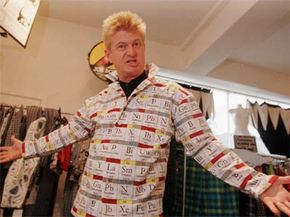Trends in the Periodic Table
It's handy to know about what group a particular element resides in and what its atomic structure is like, but that's not all the periodic table has to tell you. If you're looking at it, you're casually taking in work that scientists have spent lifetimes struggling with. And if you look at the table as a whole, some big trends start to emerge that tell us how one element will react with another.
Before we can see these trends, a quick chemistry recap might be good. First, metals react with nonmetals to form ionic compounds. The nonmetal atom takes one or more valence electrons from the metal atom. When an atom gains or loses a valence electron, it forms an ion. An ion with more protons than electrons is positively charged and called a cation (comes from the metal). An ion with more electrons than protons is negatively charged and is called an anion (comes from the nonmetal). In the end, both ions have a full outer energy level. Second, nonmetals tend to share electrons so that both atoms have full outer energy levels; they form covalent compounds. But how do you know which element will react with which to produce an ionic or a covalent compound? That depends on a few factors:
Advertisement
- Ionization energy: the amount of energy it takes to strip away the first valence electron
- Electronegativity: a measure of how tightly an atom holds onto its valence electrons
- Nuclear charge: the attractive force between the positive protons in the nucleus and the negative electrons in the energy levels. The more protons, the greater the nuclear charge.
- Shielding: inner electrons tend to shield the outer electrons from the attractive force of the nucleus. The more energy levels between the valence electrons and the nucleus, the more shielding.
Let's see how these factors can help predict what type of chemical reactions any two elements will make.
If you look at the periodic table, ionization energy tends to decrease as you move down a column and increase as you move across a period from left to right. When you compare elements in groups 1 and 2 (on the left) with those in 16 and 17 (on the right), you'll find that the elements in the first groups have lower ionization energies, won't hold on to their valence electrons as tightly and will tend to form cations. So, elements in groups 1 and 2 will tend to form ionic compounds.
Like ionization energy, electronegativity decreases as you go down a column and increases as you go across a period from left to right. So, fluorine is more likely to take electrons from another element than lithium. The difference in electronegativity between two elements will determine whether they exchange electrons (ionic compounds) or share electrons (covalent compounds). You can use trends in ionization energy and electronegativity to predict whether two elements will form ionic or covalent compounds.
Lastly, the nuclear charge increases as you go across and down the table, while the shielding stays constant across the periods, but increases as you go down the columns. These tendencies tell you about atom size. Atoms and ions get bigger as you go down the columns because the shielding effect outweighs the effects of the nuclear charge, so the attraction between the nucleus and electrons is weaker and the atom expands in size. In contrast, atoms get smaller as you go across the periods because the nuclear charge effect outweighs the shielding effect, so the attraction between the nucleus and the electron is greater and the atom shrinks in size.
It's hard to believe that one measly sheet of paper can contain that much information.
